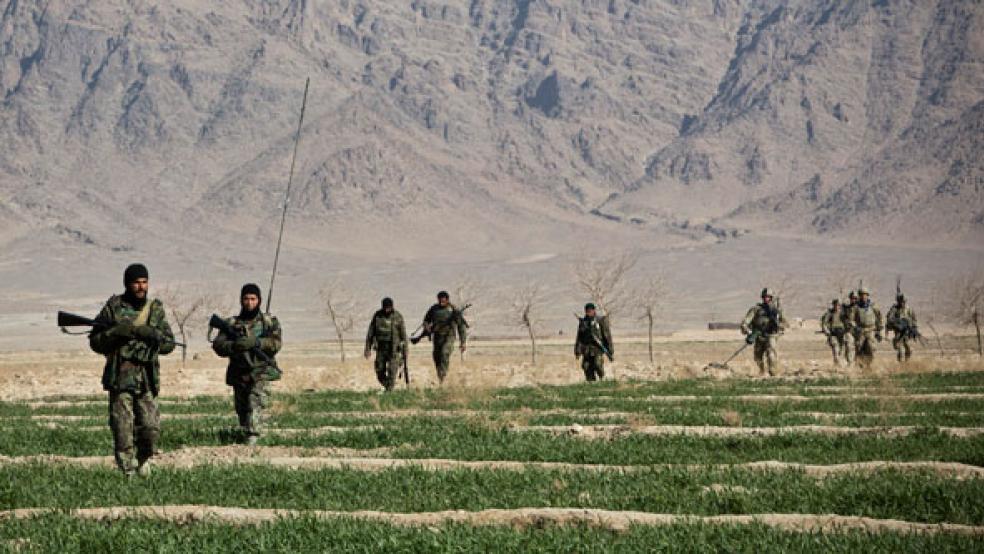As the United States prepares to end the Afghan war after more than a decade of fighting, the financial cost of America leaving is still a mystery. But according to a recent Government Accountability Office report, the lives lost and money spent there will have been for naught without additional billions in U.S. assistance.

The first challenge the U.S. military faces is simply moving out of the country. According to the report, the cost of removing the weapons of war necessary could be as high as $6 billion. However, this number does not account for the cost of moving personnel out of the theater. And because of the logistical challenges of moving equipment out of the country, the cost of withdrawal could be much higher.
“DOD faces an unprecedented logistical challenge. Removing equipment from Afghanistan requires transiting routes with physical and geopolitical challenges. These factors could increase costs and slow the drawdown of an estimated 50,000 vehicles and more than 90,000 containers,” GAO found.
Gordon Adams, an American University professor and defense budget expert, said that the true cost of withdrawal is likely to never to be known. The Pentagon does not have a line item for withdrawal in its budget. He said the cost of moving people and machines out of Afghanistan would be take from DOD’s operations and management budget, and would not be tracked as a single expense.
“None of [the withdrawal cost] is identified by …line item,” he said. “Sorting it out is also possible if the department does an internal sort… but it’s going to be buried. There’s no way to accurately tell. It would only be determined by the military and there’s no independent way of verifying that."
The cost of withdrawal was only one of the unknowns highlighted by GAO. The government auditor made it clear that long-term financial commitments in the tens of billions of dollars are needed to sustain the gains made in the Afghan war.
According to the GAO report, released last week, Afghanistan would essentially collapse without U.S. financial support since it does not have enough money to pay for its own security forces. It doesn’t generate nearly enough revenue to maintain a viable government. And the tens of billions of development dollars meant to revive the Afghan economy and create strong government institutions have largely been wasted or stolen.
From a security standpoint, the GAO’s finding that the Defense Department has made no public plans on how to insure the Afghan National Defense Forces are viable after the withdrawal is troubling.
“A shortfall currently exists in Afghan domestic revenue and international commitments to cover the anticipated costs of Afghan security forces, and despite past recommendations and a congressional mandate, the Department of Defense … has not routinely provided long-term cost estimates for sustaining those forces,” GAO found.
International donors are responsible for $33.7 billion, or 95 percent of all of the Afghan military’s funding, with the United States providing $32.4 billion or 91 percent of that total. Without that money, Afghanistan is in danger of returning to the lawless state it was before the 2001 war began.
“The U.S. strategic goal for Afghanistan is to defeat and prevent the return of al Qaeda and its affiliates. Since fiscal year 2002, U.S. costs reported for U.S. military, U.S. diplomatic, and reconstruction and relief operations in Afghanistan have been over $500 billion,” GAO found. “Significant oversight will be needed to help ensure visibility over the cost and progress of these efforts.”
In other words, if the United States does not develop a plan to pay to maintain and develop the Afghan military, any gains made since the start of the war would be lost, and more than $500 billion would have been wasted. That money does not include the 2,047 soldiers killed or the 18,230 maimed, or the cost of their ongoing care and rehabilitation.
It’s not just Afghan security forces that are at risk of falling apart. According to GAO, the country’s government infrastructure is also likely to collapse without broader international support since it, too, is almost entirely dependent on international donors for revenue.
For instance, from 2006 to 2011, Afghanistan only accounted for 10 percent of total public expenditures. Even as domestic revenues have grown from just $600 million in 2006 to $2 billion in 2011, public expenditures increased over that time from $5.8 billion to $17.4 billion. The shortfall was covered largely by the United States, with Washington springing for 37 percent of all non-security expenditures.
The main problem is that Afghanistan has no way to generate its own revenue. It doesn’t have a functioning infrastructure or national economy, has no formal tax collection system, and the entire country is riddled with corruption.
With no end to the U.S. financial commitment in sight, and the growing probability that many of the hard-fought gains made in Afghanistan will be lost, some are wondering whether it’s best to cut the fiscal cord right now.
“The issue is not whether we can but whether we should,” Malou Innocent, a foreign policy analyst at the Cato Institute, wrote in a recent policy paper. “Only recently has the debate moved to this question. Should we remain in Afghanistan? The answer — when stacked against our objective of disrupting, dismantling, and defeating al Qaeda — is clearly no.”
The United States Agency for International Development has tried to improve conditions in Afghanistan, but with little luck and at an expansive cost. In 2010, The Fiscal Times reported that the United States could not account for the vast majority of development money sent to Afghanistan. Soon after, the head of the inspector general for Afghan reconstruction resigned. More than two years later, GAO has determined that little has changed.
“[T]he U.S. government could not fully determine the overall extent to which its efforts had improved the Afghan government’s public financial management capacity because … U.S. agencies have reported mixed results; and … weaknesses in USAID’s performance management frameworks, such as lack of performance targets and data, prevent reliable assessments of its results.”
Brianna Ehley of The Fiscal Times contributed reporting.





